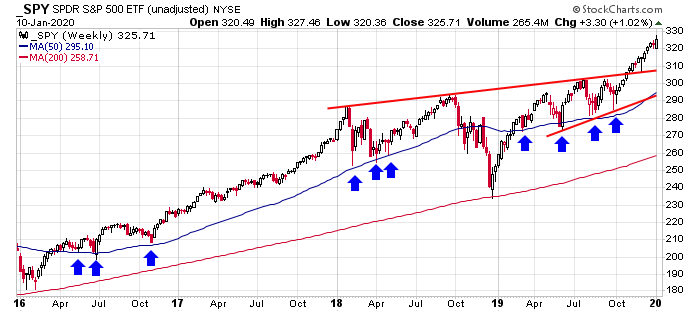LB Weekly (Jan 12)
by
admin on January 12, 2020
in
Charts/Essays/Reports
2 Comments
2020 has gotten off to a solid start.
In its first full week of trading, the S&P 500 posted a gain 3/5 days and hit a new all-time high three consecutive days to end the week. Mega caps continued to lead – Apple, Microsoft, Google and Facebook all closed at new highs. And this week software names joined – ZM, OKTA, RNG, TWLO, ZEN, AYX, AVLR, COUP and many others did great.
Quant studies are starting to point to 2020 being a good year. Since 1950, when the first 5 days of the year are positive, the market has posted a gain 36/45 times (80%), with an average/median gain of 13.6%/13.6%. This is only slightly better than “all years,” so don’t get too excited. But when the S&P gains more than 0.65% in the first five days, as it did this year, the index posts a full year gain 31/35 times (89%), with an average/median gain of 17.2%/20.9%. Much more encouraging.
These types of stats don’t guarantee anything, but they do provide a solid backdrop. I believe the biggest loss in the market is cash sitting on the sideline. Negative headlines produce enough doubt to keep traders and investors under-exposed, and when the market runs up like it has the last three months, gains are made, but they’re much smaller than they should have been. A key to trading is to fully take advantage of opportunities. If knowing that over the last 70 years when the market was up 0.65% the first five days of January produced a 89% win rate for the year, perhaps traders and investors wouldn’t be under-invested. Anything can happen in any given year, and we of course don’t know what the path the market will travel, but if you can stomach an occasional down year, the up years will more than make up the difference.
We enter 2020 with the trend being up, leaders leading, and very supportive internals. This by itself keeps us in the bulls’ camp, only interested in the long side. Add that this is an election year – a traditionally positive year – and historical studies are starting to hint at further gains, we have no choice but to be optimistic looking forward.
Again, we don’t know what path the market will travel. And it’s entirely possible this is one of the 11% of the years that doesn’t do well after posting a 0.65% gain. But if you want to make money, you have to take a risk. You have to do something. The “wall of worry” operates to keep people on the sidelines. That’s its job. That’s its role. It keeps people at bay, so acute traders like us can establish positions within trends. And when FOMO (fear of missing out) kicks in, and that sideline money is put to work, our positions get juiced.
You can be long, short or on the sidelines…and of course there’s some gray area. I choose to be long. Individual trades must be managed wisely because any stock can do anything while the market steadily trends up. But being long is the way to go. Be willing to take a risk to expose yourself to the upside while managing the downside. Nothing works all the time, but if operate like this and are willing to accept a few losses, you’ll do great over time.
Again, negative news operates to keep traders and investors on the sidelines. That’s its role. Recognize the deception and don’t let it affect you. The charts are your best source of reliable information. I trust them more than I trust anything else.
Let’s get to charts and see if there are any changes.
Indexes
The S&P 500 & Russell 2000 Weeklies (via SPY & IWM): The S&P posted a solid gain for the week. The Russell, due to selling Thursday and Friday, closed down slightly and in the middle of its weekly range. These two charts would suggest the large caps are doing much better than the small caps, but this isn’t the entire story. Measured of the Dec 2018 bottom, the S&P is up 38% while the Russell is up 30%. That’s not a huge difference. The reason the S&P is well into new high territory and the Russell still hasn’t taken out its 2018 high is because the Russell fell so much more in Q4 2018. Without that the Russell would also be at an all-time high. Perhaps I’m, searching too hard. This is just my way of saying the situation isn’t as drastic as it seems. But I’d still like the see some improvement from the small caps. I’d like to see them lead some. Under performing is not a good backdrop.



 1 min
1 min

